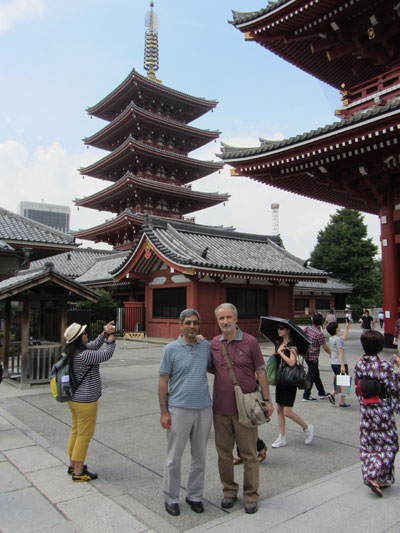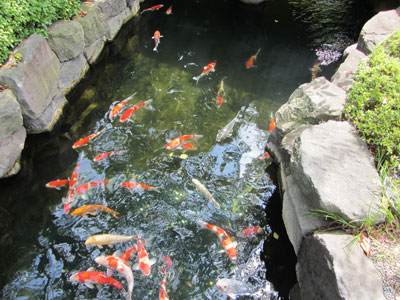Hiroshima Travelogue - Episode 5
Today, I cruised the streets of Tokyo; the city abounds with long and narrow streets, underpasses, footbridges, cars, discipline. The many locks attached on every lamp post and public telephones and the nuts and bolts used in iron structures are evident of the fact that quakes are on a constant go in the city and, probably, its neighboring towns. Humidity is also considerable. All the essentials of the city are made of iron strictures and rust is born where of iron and humidity are together.
A meeting is arranged at Iran's embassy in the afternoon between members of the Peace Museum and Iranians living in Tokyo. Everyone is invited to listen to the addresses made by some of the visitors. In his opening speech, Dr. Shahryar Khateri delivers a report on the professional and emotional links in the past ten years between Iranian and Japanese doctors and survivors of mass destruction weapons, both atomic and chemical. Later in the meeting, Ali Akbar Fazli, the one-hand-and-foot man and a Sacred Defense veteran, spoke for the audience about his injuries, his life and the promising future under peaceful conditions. Behrouz Abbasi, chemically injured war veteran, was the next speaker. He is one of the ten survivors of the intelligence unit of the Sarallah Division operation. Almost 60 of his friends perished during the war. His coughs and eyes would tell you that his lungs are disabled with mustard gas and his corneas are already replaced. Alireza Yazdan Panah is waiting for lung transplantation operation as well. He always has an oxygen supply with him. The three are members of the Peace Museum and have volunteered to serve the place as guides. Alireza’s speech is an answer to the question of “why should we love each other?â€
The audience would also listen to Parviz Parastouei’s words as well. “Whatever I have today is the result of wearing the cloths of war heroes and playing their roles in movies,†said Parviz (veteran movie star in Iran renowned for his Sacred Defense acts).

Mordad 12 (August 3)
We head to the Asakusa Shrine in the morning. The place is like a faithful destination to every Tokyo visitor; a fact which is evident in the large number of its visitors. There is this other shrine named the Sensoji Temple beside the shrine. These are two famous Shinto and Buddhist shrines in Tokyo. They are like our own holy shrines and to reach them you would half to pass through a narrow, cramped market. Tiny shops placed one beside another eagerly welcome your eyes, and pockets. Here, you can find whatever you want as a souvenir; but instead of traditional Iranian candies, they cook these small cookies that can be eaten hot and kept in the mind for their taste.

There is a small pond at the entrance of the temple where every visitor takes some water from, with a special ladle to wash their face and mouth-something similar to Islamic Vudu. Then, they take the stairs and drop a coin into a cavity, maybe as an offering. They also tie paper ribbons as well. I crane my neck over into the shrine; sitting or kneeling on the floor are a number of guys having put their hands on their faces saying things; a smoke can also be seen. A small river with large golden fish flows beside the two temples.

A few minutes later, we rush to an exchange center to change our dollars with Yen. A simple review of elementary arithmetic, tell me how feeble this Rial of ours has become. The exchange boy says something while changing the money to which we nod only. One of our experienced fellows says he is speaking the requirements of an exchange: “I paid you this much and received this muchâ€.
Reviewing the prices has found a different meaning. Whatever you pick is too hot to be bought.
To be continued…
Hedayatollah Behboudi
Translated by: Abbas Hajihashemi
Number of Visits: 7147








The latest
- The Necessity of Standardizing Oral History and Criticism of General Mohsen Rezaei
- The 368th Night of Remembrance – Part 1
- Oral History News of Khordad 1404 (May 22nd – June 21st 2025)
- Najaf Headquarters Human Resources
- The Embankment Wounded Shoulders – 12
- Annotation
- The 367th Night of Memory– 5
- The Founder of Hosseiniyeh Ershad
Most visited
Operation Beit al-Moqaddas and Liberation of Khorramshahr
After Operation Fat’h al-Mobin, we traveled to Kermanshah and visited Sar-e-Pol-e-Zahab before heading to Ilam. During Operation Beit al-Moqaddas, the 27th Brigade was still receiving support from the West. We maintained contact with individuals who had previously worked in Area 7 and were now leading the brigade. It was through these connections that I learned about Operation Beit al-Moqaddas.Memoirs of Hujjat al-Islam Reza Motalebi
Hujjat al-Islam Reza Motalebi is a cleric from Isfahan. Before the revolution, he was the imam of the Fallah Mosque – which was later renamed Abuzar Mosque. By his presence and efforts, Abuzar Mosque soon became a base for supporters of the Imam and the revolution. After the victory of the revolution, he played a role in uniting forces and maintaining political vitality in southwest Tehran.The Necessity of Receiving Feedback in Oral History
Whenever we engage in a task, we naturally seek ways to evaluate our performance — to correct shortcomings and enhance strengths. Such refinement is only possible through the feedback we receive from others. Consider, for instance, a basketball player whose shots are consistently accurate; should he begin shooting blindfolded, his success rate would rapidly decline, as he would be deprived of essential feedback from each attempt.Sir Saeed
The book “Sir Saeed” is a documentary [narrative] of the life of martyr Seyyed Mohammad Saeed Jafari, written by Mohammad Mehdi Hemmati and published by Rahiyar Publications. In March 2024, this book was recognized as one of the selected documentary biographies in the 21st edition of the Sacred Defense Book of the Year Award. The following text is a review on the mentioned book.

